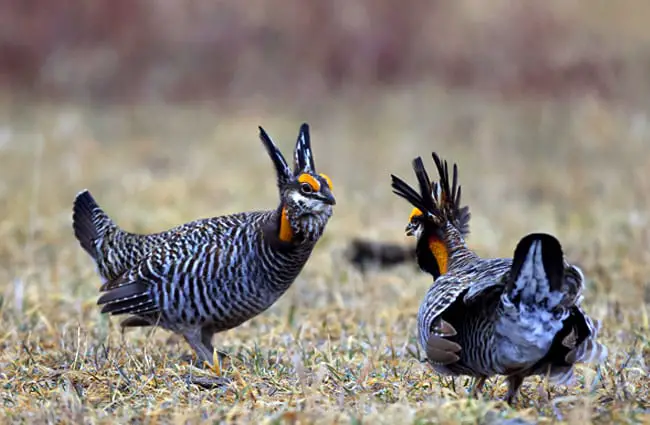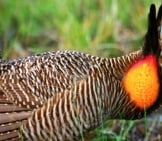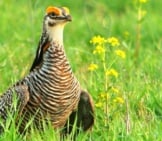Prairie chickens are North American birds that live in the Midwest. There are two species of prairie chickens, the greater prairie chicken, and the lesser prairie chicken.
These birds are part of the Phasianidae family, along with pheasants, grouse, chickens, turkeys, and more. Sadly, prairie chickens are relatively rare and their populations are fragmented. Read on to learn about the prairie chicken.
Description of the Prairie Chicken
These creatures are interesting looking to say the least. They are light colored, with brown barring across their feathers and short tails. Most individuals are a little over a foot long, and weigh no more than three pounds.
The appearance of the males is where it gets weird. Male prairie chickens have long feathers on their heads, which they can stand straight up like horns. On either side of their necks they have large, round, featherless patches of bright orange skin.
Interesting Facts About the Prairie Chicken
These birds don’t just look weird, they are actually quite odd creatures. They make odd noises, and have an oddly sad history. Learn more below.
- Booming Bird – These birds are also known as “boomers,” and for good reason. During breeding season the males make a loud, booming call by inflating their throats. This also expands their large yellow throat patches. Female prairie chickens find this irresistible, apparently.
- Putting on a Show – Males don’t just stop at loud booming sounds. They also like to put on a little show for the ladies. In addition to booming noises and inflated throat pouches, they also like to do some interesting dances. The males stomp their feet and leap high in the air in an attempt to garner admirers!
- Sad Subspecies – Unfortunately, all the singing and displaying in the world can’t save a species from humans. Human activity threatens both species with extinction, and some subspecies are in even more dire positions.
- Heath Hen – One subspecies of prairie chicken, the heath hen, is extinct. Scientists believe that this creature might have been a separate species, but are unsure. Sadly, humans drove heath hens to extinction in 1932.
Habitat of the Prairie Chicken
Prairie chickens have a specific type of habitat that they prefer… can you guess what it might be? That’s right, prairie chickens like living in prairies! Specifically, they inhabit prairies with tall grasses, and prairie-woodland mixed habitats.
Nowadays, they also live in prairies mixed with farms and agricultural areas. Unfortunately, they are less successful in agricultural areas, and birds living in ecosystems exclusively consisting of tallgrass prairie have higher populations.
Distribution of the Prairie Chicken
These birds have an extremely wide and patchy distribution. They live across the Midwest United States, but are rare in most areas, and large uninhabitable areas without prairie chickens often separate their populations.
There are several small populations in Texas, New Mexico, Colorado, Oklahoma, and several other states. Kansas, Nebraska, South Dakota, and North Dakota all have large areas of prairie chicken habitat.
Diet of the Prairie Chicken
Prairie chickens eat a variety of plants and insects, depending on the season. During the summer insects are much more plentiful, and the birds feed on grasshoppers, spiders, flies, larvae, beetles, berries, and more.
In wintertime they feed on acorns, leaves, seeds, grasses, and grains. Because younger birds grow at a faster rate, they require more protein, and thus eat more insects.
Prairie Chicken and Human Interaction
Unfortunately, human interaction is usually negative to prairie chickens. Because these birds are so picky about their habitat, urbanization and habitat destruction all but extirpated these birds from the vast majority of their range.
Conservation efforts helped increase their populations, but habitat destruction continues to threaten them. The IUCN lists both the lesser and greater prairie chickens as Vulnerable.
Domestication
Humans have not domesticated prairie chickens in any way.
Does the Prairie Chicken Make a Good Pet
No, prairie chickens do not make good pets. They are not chickens, but wild birds with specific and complicated needs. In most places, it is also illegal to own a prairie chicken as a pet.
Prairie Chicken Care
In zoos, captive populations help ensure the long-term survival of the species. Various breeding programs raise birds for the purpose of releasing them back into the wild.
These programs are incredibly successful, and the birds reproduce readily in zoos. They eat a variety of vegetation and insects, and zookeepers also feed them pelleted feed to ensure they get all the necessary nutrients.
Behavior of the Prairie Chicken
Male prairie chickens are highly territorial, and their territories contain two primary components: feeding grounds and booming grounds. The booming grounds are where the male performs his mating dances and calls, and the feeding grounds are where he searches for food. The male breeds with multiple females, and the females take over all of the incubation and chick rearing duties.
Reproduction of the Prairie Chicken
After mating with a male, female prairie chickens move a little ways away from the male’s territory to build a nest. She constructs the nest on the ground, and lines it with grass and feathers. A single female lays up to 17 eggs, though a normal clutch contains 10 – 12 eggs.
She incubates the eggs for 23 – 25 days, and cares for the young chicks until they are around 3 months old. As soon as they hatch the chicks can follow their mother and forage for food. Mothers lead their chicks to food and protect them from predators and hazardous weather.











![Red Angus Closeup of a beautiful Red Angus cowPhoto by: U.S. Department of Agriculture [pubic domain]https://creativecommons.org/licenses/by/2.0/](https://animals.net/wp-content/uploads/2020/03/Red-Angus-4-238x178.jpg)


![Red Angus Closeup of a beautiful Red Angus cowPhoto by: U.S. Department of Agriculture [pubic domain]https://creativecommons.org/licenses/by/2.0/](https://animals.net/wp-content/uploads/2020/03/Red-Angus-4-100x75.jpg)

